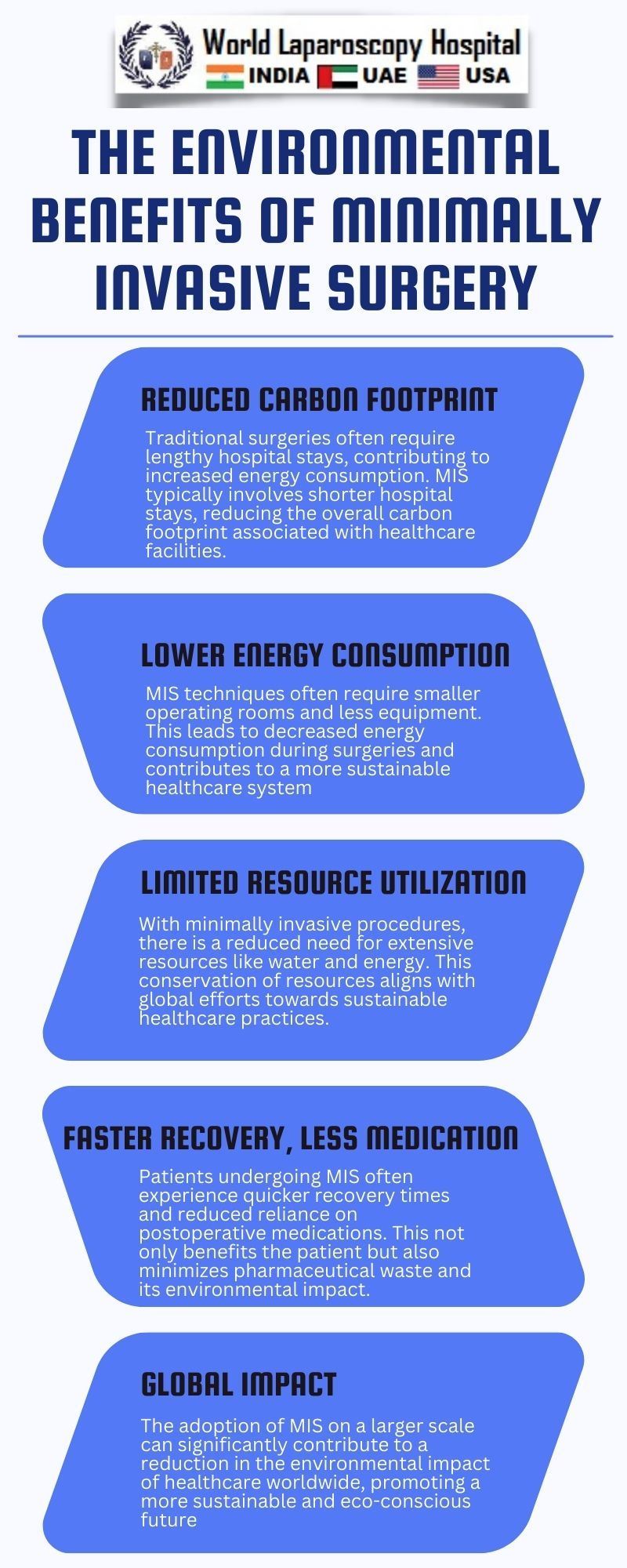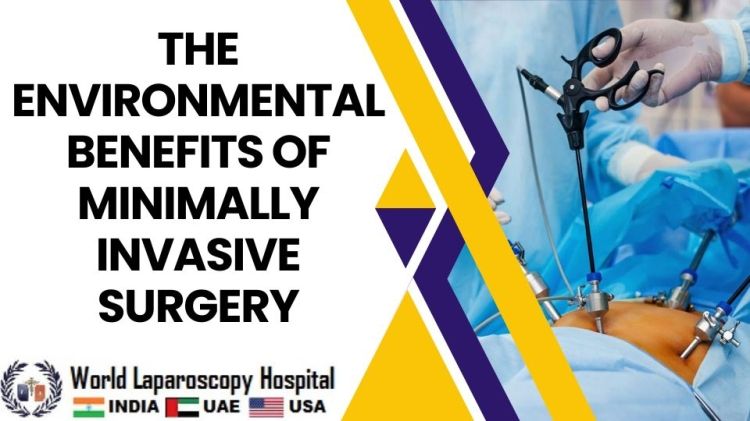The Environmental Benefits of Minimally Invasive Surgery
Title: The Environmental Benefits of Minimally Invasive Surgery
Introduction:
In the ever-evolving landscape of healthcare, the quest for innovative and sustainable medical practices has gained momentum. Among these advancements, Minimally Invasive Surgery (MIS) stands out not only for its medical efficacy but also for its notable environmental benefits. This article delves into the eco-friendly facets of MIS, exploring how this surgical approach contributes to a healthier planet.

Understanding Minimally Invasive Surgery:
Before delving into its environmental impact, it's essential to comprehend what Minimally Invasive Surgery entails. MIS, also known as laparoscopic or keyhole surgery, involves performing procedures through small incisions using specialized instruments and a camera. This stands in stark contrast to traditional open surgery, which requires larger incisions, leading to extended recovery times and increased environmental ramifications.
Reducing Resource Consumption:
One of the primary environmental advantages of MIS is its ability to minimize resource consumption. Traditional surgeries often demand more resources, including larger amounts of surgical equipment, drapes, and other disposable materials. In contrast, MIS utilizes smaller instruments, necessitating fewer resources and reducing the overall environmental footprint of each procedure.
Additionally, MIS procedures often require less blood loss, leading to a decreased need for blood transfusions. This not only benefits patient health but also contributes to resource conservation in healthcare settings, where the demand for blood can strain the available supply.
Curbing Greenhouse Gas Emissions:
Greenhouse gas emissions, a major contributor to climate change, are a growing global concern. Traditional open surgeries typically involve longer hospital stays and recovery periods, leading to increased energy consumption and subsequently higher carbon emissions. The shorter hospital stays associated with MIS translate to reduced energy usage, contributing to lower overall carbon footprints.
Moreover, MIS procedures generally require less anesthesia, which is known to be a potent greenhouse gas. By minimizing the amount of anesthesia used, these surgeries further mitigate their impact on climate change, aligning with the global push for sustainable healthcare practices.
Waste Reduction and Sustainability:
The environmental toll of medical waste is a critical consideration in the quest for sustainable healthcare. Traditional surgeries generate more waste due to the larger incisions, increased use of disposable materials, and longer recovery times. MIS, with its smaller incisions and reduced need for disposable items, contributes significantly to waste reduction.
The shift towards MIS also encourages the development and use of more sustainable materials in medical devices. As the demand for minimally invasive procedures grows, manufacturers are motivated to create instruments and tools that are not only effective but also environmentally conscious. This shift towards sustainability in medical device production is a positive step towards a greener healthcare industry.
Energy Efficiency in Healthcare Facilities:
Beyond the surgical suite, the environmental impact of healthcare extends to the energy consumption of medical facilities. Traditional surgeries, with their longer recovery times and extended hospital stays, demand more energy for patient care, lighting, heating, and cooling. In contrast, MIS procedures, with their shorter recovery periods, contribute to enhanced energy efficiency in healthcare facilities.
The reduction in energy usage associated with MIS aligns with the broader push for sustainable practices in the healthcare sector. As healthcare providers strive to minimize their environmental impact, the adoption of MIS becomes a crucial component of achieving energy efficiency and sustainability goals.
Patient-Centric Benefits and Environmental Synergy:
While the environmental benefits of MIS are compelling, it's essential to recognize that these advantages align with improved patient outcomes. Shorter hospital stays mean quicker recovery times for patients, reducing the strain on healthcare resources and minimizing the need for prolonged use of medications and other interventions.
The synergy between patient-centric benefits and environmental sustainability is a hallmark of MIS. As healthcare systems strive to provide high-quality care while minimizing their ecological footprint, MIS emerges as a key player in achieving a balance between patient well-being and environmental responsibility.
Challenges and Opportunities for Further Improvement:
Despite its environmental advantages, MIS is not without challenges. The initial costs associated with acquiring specialized equipment for minimally invasive procedures can be a barrier for some healthcare facilities. However, it's crucial to recognize that the long-term benefits, both in terms of patient outcomes and environmental impact, often outweigh these upfront expenses.
Continued research and innovation in the field of minimally invasive techniques present opportunities for further improvement. This includes the development of more sustainable materials, advancements in surgical robotics, and increased accessibility to MIS in diverse healthcare settings. By addressing these challenges and seizing opportunities for improvement, the environmental impact of MIS can be maximized.
Conclusion:
Minimally Invasive Surgery emerges as a beacon of hope in the realm of environmentally conscious healthcare practices. From resource conservation and waste reduction to energy efficiency and lower carbon emissions, the environmental benefits of MIS are multifaceted. As the healthcare industry navigates the path towards sustainability, embracing and expanding the adoption of minimally invasive techniques is not just a medical imperative but an ecological necessity. By prioritizing the environmental advantages of MIS, we can pave the way for a greener, healthier future for both patients and the planet.
Top
Introduction:
In the ever-evolving landscape of healthcare, the quest for innovative and sustainable medical practices has gained momentum. Among these advancements, Minimally Invasive Surgery (MIS) stands out not only for its medical efficacy but also for its notable environmental benefits. This article delves into the eco-friendly facets of MIS, exploring how this surgical approach contributes to a healthier planet.

Understanding Minimally Invasive Surgery:
Before delving into its environmental impact, it's essential to comprehend what Minimally Invasive Surgery entails. MIS, also known as laparoscopic or keyhole surgery, involves performing procedures through small incisions using specialized instruments and a camera. This stands in stark contrast to traditional open surgery, which requires larger incisions, leading to extended recovery times and increased environmental ramifications.
Reducing Resource Consumption:
One of the primary environmental advantages of MIS is its ability to minimize resource consumption. Traditional surgeries often demand more resources, including larger amounts of surgical equipment, drapes, and other disposable materials. In contrast, MIS utilizes smaller instruments, necessitating fewer resources and reducing the overall environmental footprint of each procedure.
Additionally, MIS procedures often require less blood loss, leading to a decreased need for blood transfusions. This not only benefits patient health but also contributes to resource conservation in healthcare settings, where the demand for blood can strain the available supply.
Curbing Greenhouse Gas Emissions:
Greenhouse gas emissions, a major contributor to climate change, are a growing global concern. Traditional open surgeries typically involve longer hospital stays and recovery periods, leading to increased energy consumption and subsequently higher carbon emissions. The shorter hospital stays associated with MIS translate to reduced energy usage, contributing to lower overall carbon footprints.
Moreover, MIS procedures generally require less anesthesia, which is known to be a potent greenhouse gas. By minimizing the amount of anesthesia used, these surgeries further mitigate their impact on climate change, aligning with the global push for sustainable healthcare practices.
Waste Reduction and Sustainability:
The environmental toll of medical waste is a critical consideration in the quest for sustainable healthcare. Traditional surgeries generate more waste due to the larger incisions, increased use of disposable materials, and longer recovery times. MIS, with its smaller incisions and reduced need for disposable items, contributes significantly to waste reduction.
The shift towards MIS also encourages the development and use of more sustainable materials in medical devices. As the demand for minimally invasive procedures grows, manufacturers are motivated to create instruments and tools that are not only effective but also environmentally conscious. This shift towards sustainability in medical device production is a positive step towards a greener healthcare industry.
Energy Efficiency in Healthcare Facilities:
Beyond the surgical suite, the environmental impact of healthcare extends to the energy consumption of medical facilities. Traditional surgeries, with their longer recovery times and extended hospital stays, demand more energy for patient care, lighting, heating, and cooling. In contrast, MIS procedures, with their shorter recovery periods, contribute to enhanced energy efficiency in healthcare facilities.
The reduction in energy usage associated with MIS aligns with the broader push for sustainable practices in the healthcare sector. As healthcare providers strive to minimize their environmental impact, the adoption of MIS becomes a crucial component of achieving energy efficiency and sustainability goals.
Patient-Centric Benefits and Environmental Synergy:
While the environmental benefits of MIS are compelling, it's essential to recognize that these advantages align with improved patient outcomes. Shorter hospital stays mean quicker recovery times for patients, reducing the strain on healthcare resources and minimizing the need for prolonged use of medications and other interventions.
The synergy between patient-centric benefits and environmental sustainability is a hallmark of MIS. As healthcare systems strive to provide high-quality care while minimizing their ecological footprint, MIS emerges as a key player in achieving a balance between patient well-being and environmental responsibility.
Challenges and Opportunities for Further Improvement:
Despite its environmental advantages, MIS is not without challenges. The initial costs associated with acquiring specialized equipment for minimally invasive procedures can be a barrier for some healthcare facilities. However, it's crucial to recognize that the long-term benefits, both in terms of patient outcomes and environmental impact, often outweigh these upfront expenses.
Continued research and innovation in the field of minimally invasive techniques present opportunities for further improvement. This includes the development of more sustainable materials, advancements in surgical robotics, and increased accessibility to MIS in diverse healthcare settings. By addressing these challenges and seizing opportunities for improvement, the environmental impact of MIS can be maximized.
Conclusion:
Minimally Invasive Surgery emerges as a beacon of hope in the realm of environmentally conscious healthcare practices. From resource conservation and waste reduction to energy efficiency and lower carbon emissions, the environmental benefits of MIS are multifaceted. As the healthcare industry navigates the path towards sustainability, embracing and expanding the adoption of minimally invasive techniques is not just a medical imperative but an ecological necessity. By prioritizing the environmental advantages of MIS, we can pave the way for a greener, healthier future for both patients and the planet.
